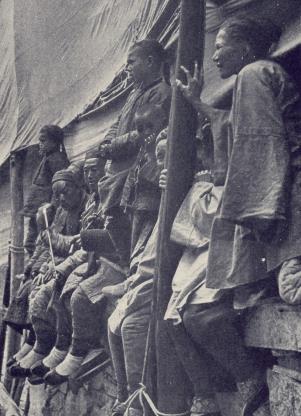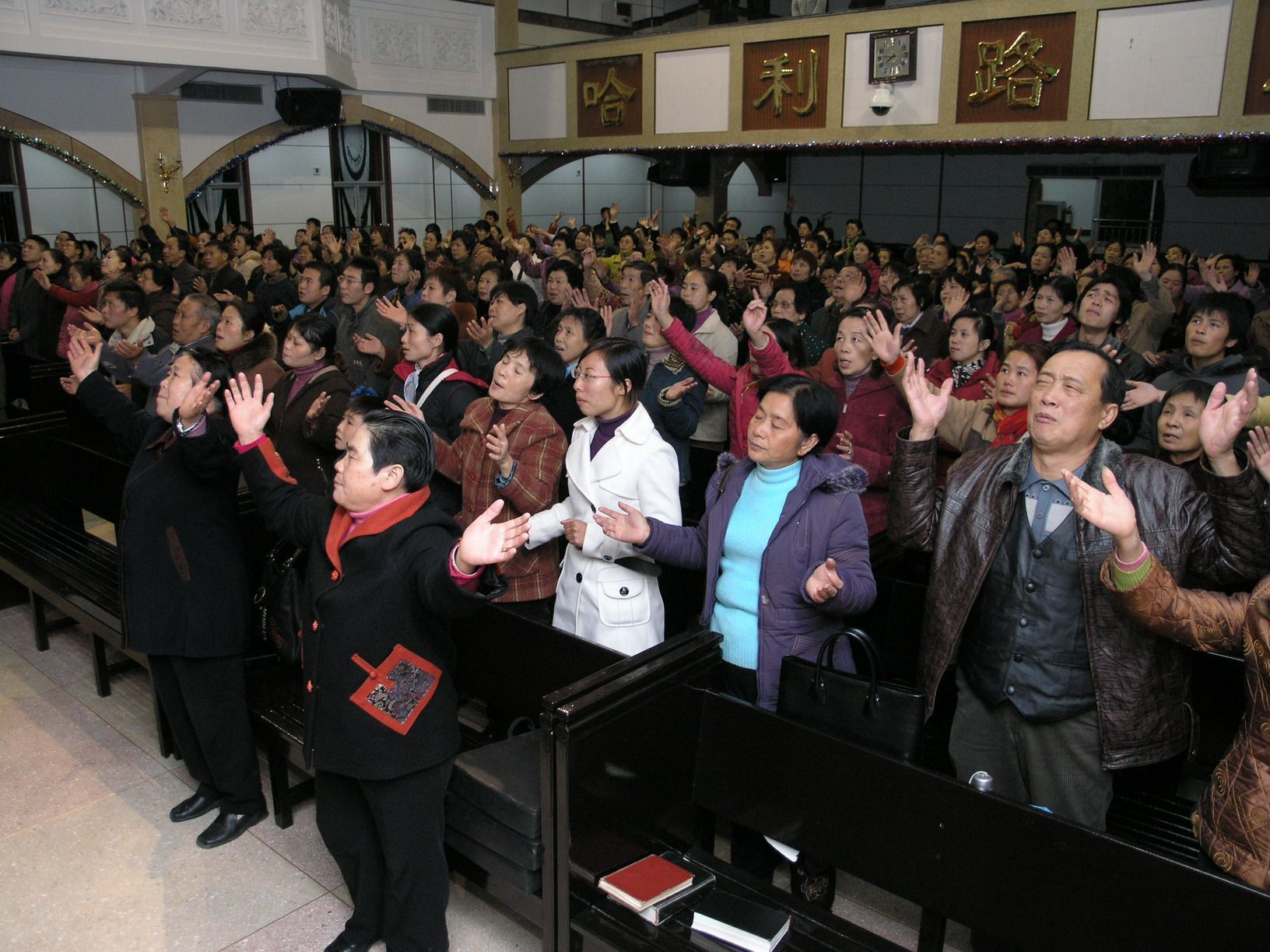1920s

Buddhist pilgrims fascinated by a Gospel presentation at Tai'an in the 1920s.
Most of the 1920s was a difficult time for the Church in Shandong. Society was in a state of upheaval, with the civil war raging, violent warlords dominating large areas, and the ever-present twin plagues of famines and floods afflicting millions of people.
Despite these severe trials, the Christians of Shandong continued to grow in grace and in number in the early part of the decade. Whereas a survey in 1904 found there were only 14,226 Evangelical Christians in the entire province,1 by 1922 the number had nearly quadrupled to 53,480.2
Only the provinces of Fujian (86,094), Guangdong (78,519) and Jiangsu (70,084) contained more Evangelical Christians in China at the time.
By comparison, however, the Catholics had mushroomed in Shandong, reporting 149,730 members in 807 churches in the same year.3
By the late 1920s, however, the Church in Shandong had fallen away alarmingly and was in dire need of an infusion of spiritual life. The 1929 China Christian Year Book summarized the state of the Shandong churches with this grim assessment:
"Not a few of our Christian people feel utterly depressed and exhausted; a kind of flatness seems to reign in the hearts of many—a lack of spirit and energy to make any forward move. The bitter experiences of the past and the uncertainty of the future have made many shy of attempting great things for God and expecting great things from God."4
The 50-Year-Old Baby
The spiritual backsliding of churches throughout Shandong impacted a vast number of congregations. In one county, 18 churches had been established over the decades, but their reliance on foreign funds to keep them going had eroded the vitality of local believers and held back their spiritual growth, to the point that some people called the head church, "The 50-year-old baby."
At the end of one year, the finance committee of the 18 churches visited the village where the main congregation was located and scolded the believers for their lack of giving to God's work. Only a fraction of the pledges the local Christians had made the previous year had been honored, and as a result the Christian school could not afford to reopen in the new year. Parents had enjoyed the benefits of sending their children there without contributing to the teacher's salary or the upkeep of the school.
Although many of the church members in that village were relatively wealthy land-owners, the church building had fallen into a state of disrepair. Like in the time of the prophet Hosea, the people had diligently taken care of their own homes while neglecting the building where they met to commune with God.
An urgent meeting was arranged, and all the believers were summoned to hear of the dire situation. At the very moment the preacher referred to the need to repair the church building before it became unusable, "a chunk of the wall under a beam supporting one section of the roof fell down on the audience. It was a most pointed intimation of the need of the Christians getting together and adopting some effective plans before the whole side of the building should cave in on them."5
A revival conference was arranged for the Christians in the area, and many prayers were sent heavenward as concerned believers cried out to God to break the stubborn selfishness of their backslidden churches.
On the first night of the meetings the preacher spoke from the third chapter of Malachi. As the text was presented to the people,
"Their minds under the Spirit's guidance began to grasp the heinousness of their sinfulness in God's sight—the sins of lukewarmness, of indifference to Christ, and to the propagating of His gospel; and that sinfulness became very real to them in its actual hatefulness.... It became plain to them as the meetings progressed that the source of all their troubles was in the little word 'disobey'....
On the last morning the Holy Spirit was present in special power.... At once the people began to be care-lightened and resolute in faith to face with confidence the problems of the church.... No longer did they look on these things in shame and confusion; for, though their money was not nearly enough to put the church building in shape, they now had the spirit to attack the problem. They opened two new schools in nearby villages....
At the close of the meeting the Christians looked at each other in amazement. Families that had not spoken were inviting each other to the season's feasts. Many volunteered to go out into the surrounding villages and preach. The spirit of hopefulness and the gentle warmth of mutual love were diffused; everybody's face was beaming."6
A Fresh Wind Starts to Blow
Although the Evangelical churches in many parts of the province were at a low spiritual ebb during the 1920s, there were encouraging signs that God was about to do something special. Meetings by a number of revivalists such as Marie Monsen prepared the soil for what was to come. Missionary Leslie Lyall stated that in 1927,
"The pioneer of the spiritual 'new life movement', the handmaiden upon whom the Spirit was first poured out, was Marie Monsen of Norway. Her surgical skill in exposing the sins hidden within the Church and lurking behind the smiling exterior of many a trusted Christian—even many a trusted Christian leader—and her quiet insistence on a clear-cut experience of the new birth, set the pattern for others to follow."7
Before God poured His Spirit out upon the Chinese churches, however, He did a deep work in the lives of the missionary community, bringing many to their knees in repentance. When a group of American Southern Baptist missionaries gathered together at Yantai in 1927, they found that one of the women, Ola Culpepper, was suffering in extreme pain because of a degenerative eye disease. She has visited numerous doctors but they could not help her, except to prescribe ever-thickening lenses for her glasses.
The missionaries discussed the promises in the fifth chapter of James, where believers are exhorted to confess their sins to one another and anoint the sick with oil. Such practices were unheard of in Southern Baptist circles at the time, but the group decided to obey the Scriptures. When Bertha Smith went to lay hands on Ola Culpepper's head in prayer, however, she was convicted of her negative attitude toward another missionary, Miss Hartwell. As she confessed her sin, two Chinese cooks who hated one another broke down in tears and reconciled in an adjacent room. During the prayer, Culpepper took off her glasses and set them aside. The Lord Jesus healed her, and her eyes never again bothered her.8
The awakening of the Shandong churches was characterized by deep confessions of sin as the Spirit of God moved on people and exposed parts of their lives that displeased the Lord Jesus. These public confessions of sin were completely contrary to typical reserved Chinese behavior, but God used them to break people and to do a deep work in their lives. American missionary R.W. Frame explained how this practice confronted normal Chinese culture:
"The Chinese are a most proud and self-righteous people. They strive above all else to hold up a good face for the world to see—whatever they do in the dark. There is only one way whereby a person may sin and yet appear innocent and respectable...and that is to keep his sin covered up. 'Nothing is sin unless it is found out' seems to be the principle on which life is run in China; so woe betides the person who exposes his neighbor's sin."9
In the last few years of the decade, new indigenous movements emerged from the Shandong churches. The Pentecostal Ling En (Spiritual Gifts) movement began at Feixian in 1928 and spread northward. This group received strong criticism from some of the more conservative church leaders, although a Presbyterian minister conceded, "There has been some excesses manifest, but on the whole the movement demonstrated marvelous evidence of the Holy Spirit."10
Even today there is disagreement regarding the legacy of the Ling En churches. Seven decades later, at the end of the twentieth century, historian Norman Cliff observed,
"These meetings produced a revival that brought renewal to the churches as well as deep division on account of excessive emotionalism and extravagant behavior. The response of the missionaries was to give systematic teaching on the work of the Holy Spirit as a corrective to this branch of the revival and to invite some of China's best Bible teachers to hold conventions in the main centers. Thus John Sung, Watchman Nee, and Wang Mingdao addressed large congregations, seeking to consolidate the fruits of the revival and warning against emotional forms of worship. In spite of these addresses, an unstructured Spiritual Gifts Movement outside the mission churches developed, the influence of which can still be felt in Shandong today after 50 years of Communist rule."11
Back from the Dead
Although the Shandong Church of the 1920s was just a foreshadow of the one to emerge in the 1930s, extraordinary reports of God's power occasionally surfaced. At Tai'an, an American Pentecostal missionary named Paul Dykstra had only labored in the city for seven months when he fell ill with typhoid and double pneumonia. In his agony he suffered seven hemorrhages of the bowels. Medically speaking, there was no hope for his recovery. The missionary himself felt his end was drawing near and he would soon be departing this world to join the Lord.
At 6:30 in the evening, Dykstra passed away and two doctors pronounced him dead. In his own words, the missionary later told how after he had been dead for 15 minutes one of the doctors, a Christian named Mrs. Lawler,
"felt a mighty spirit of rebuke over death, and rebuked death in the Name of Jesus. Shortly afterwards my eyes opened, and they heard me say, 'Oh, the music. Oh, the glory.' I looked around and when I saw I was back in this old world, a feeling of great disappointment came over me, and I said, 'Why did you call me back? I don't want to be in this old sinful world.'
I had left this dark and gloomy world and entered into a glorious place of celestial beauty and brightness. I had heard the heavenly music and the heavenly songs, and was in God's very glory and ready to enter into my everlasting habitation. Oh, the glory and the music were so beautiful, sacred, and holy that words cannot describe....
For over a week I lingered between life and death, resisting to continue in this world. But my work was not finished and He called me back to life to complete my unfinished work.... He gave me a new vision of the work He had for me to do in Shandong. I surrendered my life afresh to Him."12
Dykstra threw himself into the ministry of the gospel. The people knew his story and how the Living God had brought the missionary back from the grave, and they flocked to hear him speak. He later wrote,
"The hearts of the people were stirred upon seeing the miracle God had wrought in my life. They saw the mighty power of God and realized it was the Lord, who is the Resurrection and the Life, who had raised me up.... The Tai'an active membership was between 40 and 50, but within a year, the membership increased to about 275. The Spirit of the Lord was poured out in our midst in a most wonderful way.... Unto our Christ be all the glory!"13
Paul Dykstra summarized some of the results that occurred from his ministry after being raised from the dead:
"In the villages of Luotie and Gongli, the Lord did a most marvelous work. In three or four months, 300 souls came from raw heathenism to the Lord. There were wonderful conversions. The courts of heaven were made to rejoice. Drug addicts were set free by the power of God, and the sick were healed. From surrounding villages people heard that the True God was in our midst, and they walked many miles to the mission stations to listen to the gospel message."14
An Elderly Buddhist Couple
As the Spirit of God continued to move in people's lives throughout Shandong, many testimonies emerged of His power to save and deliver people from sin and bondage.
One Sunday a missionary was preaching in a rural church when the pastor told him of an ill 65-year-old woman who needed to go to hospital. Both the woman and her husband were Buddhists. The missionaries transported her to the Christian hospital, and while she was there the doctors and nurses led her to faith in Jesus Christ.
The old woman's life was transformed, and although she wasn't able to read, she memorized many Scripture verses and placed bookmarks in her Bible so she could find them and share them with others. When she had recovered from her illness the missionary drove her back home. When she got out of the car she bowed to her family members and proclaimed, "Look at me; I am a new person! The doctors cured my body but Jesus has cured my soul. Now I am saved!"15
Her husband was less than impressed to learn of his wife's new faith. When she knelt to pray at night he pushed her over and threw his shoes at her. Once as she was communing with God, her husband kicked her until she fell off the bed onto the floor. After that, she determined to pray outside the house. One night the husband woke from a deep sleep to hear his wife crying out in prayer for his salvation, begging God to have mercy on his soul.
The Buddhist man was puzzled at what had come over his wife. The next day he visited the pastor of the church and asked,
"What have you Christians done to my wife? She went to your hospital and came back completely changed. I have lived with her for 35 years and we fought all the time. I used to curse her and she cursed me back. I used to hit her and she hit me back. Now when I curse her, she just smiles. When I hit her, she just walks away. She does better work than ever. Last night I woke up and heard her crying and praying for me. What have you Christians done to her?"16
Not only did that sin-hardened man repent of his sins and believe, but their entire family bowed before the Lord Jesus and received His salvation.
Simeon the Story-Teller
In a time long before television and other electronic media, story-tellers were influential figures in Chinese society, earning their living by entertaining crowds with their musical instruments and stories. These men were usually very bright and clever individuals who could hold the attention of an audience for hours with their oratory skills.
After a story-teller named Simeon submitted his life to Jesus Christ, he became a diligent student of God's Word and a powerful witness for the gospel. It was said of this man,
"Simeon makes his Chinese instrument almost speak in his fervent manner of playing it and telling what the Lord has done for them all. When he recites the Scriptures, each word stands out as a living Word, under the power and anointing of the Spirit, for it is the living Word to him. He is wonderfully used of the Lord in this ministry, and the people are moved to tears as he explains in his singing fashion, how Christ was crucified for their sins, and the redemptive work of Christ Jesus. It is most impressive to see the crowds listening to him with tears running down their cheeks."17
© This article is an extract from Paul Hattaway's book 'Shandong: The Revival Province'. You can order this or any of The China Chronicles books and e-books from our online bookstore.
1. China's Millions (November 1905).
2. Stauffer, The Christian Occupation of China, p. 204.
3. Stauffer, The Christian Occupation of China, p. 202.
4. Gustav Carlberg, China in Revival (Rock Island, IL: Augustana Book Concern, 1936), p. 21.
5. Scott, Answered Prayer in China, p. 54.
6. Scott, Answered Prayer in China, pp. 57-64.
7. Valerie Griffiths, Not Less than Everything: The Courageous Women who Carried the Christian Gospel to China (Oxford: Monarch Books, 2004), p. 263.
8. Bertha Smith, Go Home and Tell: How Answered Prayer Undergirded an Adventurous Witness in China (Nashville, TN: Broadman Press, 1965), p. 39.
9. Griffiths, Not Less than Everything, p. 258.
10. Orr, Evangelical Awakenings in Eastern Asia, p. 70.
11. Cliff, "Building the Protestant Church in Shandong," p. 67.
12. Paul Stephen Dykstra, Triumphs of His Grace in Shantung China (Los Angeles, CA: Angelus Temple, 1936), pp. 12-13.
13. Dykstra, Triumphs of His Grace in Shantung, pp. 12-13.
14. Dykstra, Triumphs of His Grace in Shantung, p. 16.
15. C.L. Culpepper, The Shantung Revival (Dallas, TX: Evangelism Division, Baptist General Convention of Texas, n.d.), p. 46.
16. Culpepper, The Shantung Revival, pp. 46-7.
17. Dykstra, Triumphs of His Grace in Shantung, p. 35.





